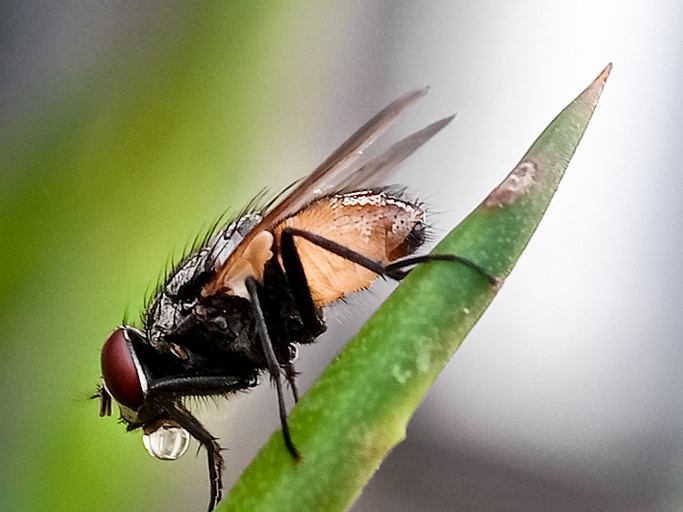
Editor’s Note: On Aug. 4, the Centers for Disease Control and Prevention (CDC) confirmed the first human case of New World screwworm (NWS) myiasis in the U.S. since it was first eradicated in the mid-20th century. The Maryland resident had recently returned from a trip to El Salvador, and has since made a full recovery. NWS myiasis is an infection, not a virus, so it is not contagious. However, it is a result of NWS larvae feeding on flesh and tissue.
“Once an infestation starts, that often attracts more flies that lay more eggs,” Dr. Max Scott, a professor in the Department of Entomology and Plant Pathology at North Carolina State University, told NPR News. “And depending where the wound is, the maggots can make their way into vulnerable tissue like the brain, or the wound can get quite big and then you get sepsis.”
A parasitic fly that was once eradicated from the United States may be on the verge of a comeback, and officials in at least one state are taking preventive action now.
The New World screwworm, or NWS, (Cochliomyia hominivorax) is native to the Western Hemisphere and a threat to livestock, wildlife, people and pets. It lays eggs in the living tissue of fresh wounds in warm-blooded animals. The larvae feed on the host’s flesh, causing severe wounds and often death if untreated, according to the Texas A&M AgriLife Extension Service.
It was eradicated from the United States in the 1960s. In the 1970s, an isolated outbreak occurred but was eliminated using a coordinated response that included the release of sterile flies, deployment of the Swormlure-2 attractant, and the insecticide Dichlorvos.
The Texas A&M AgriLife Extension Service said the release of sterile males, known as the sterile insect technique, along with regular surveillance and livestock inspections, has successfully kept NWS at bay.
Since 2023, NWS has been reestablished north of the Panama Canal. More than 6,500 cases were reported in 2024, and it has moved as far north as Veracruz, Mexico, as of May. It has not entered the United States, according to the Texas A&M AgriLife Extension Service.
Now, Texas Agriculture Commissioner Sid Miller and the Texas Department of Agriculture will work with U.S. Department of Agriculture and Secretary of Agriculture Brooke Rollins to eradicate NWS and protect the state’s cattle, sheep, goats, deer, pets and people from the devastating effects of screwworm infestation across the southern United States.
“The New World screwworm is not just a Texas problem,” Miller said. “This is a nationwide crisis with potential massive implications for American agriculture, which could result in billions of dollars in economic losses and place a heavy burden on our agriculture, wildlife industries, and public health systems.”
He directed the Texas Department of Agriculture to use an enhanced formula of Swormlure to help eradicate NWS. The synthetic bait is designed to attract adult NWS flies and may be highly effective when combined with insecticides such as Dichlorvos.
Swormlure mimics the scent of open wounds, drawing adult screwworm flies to the bait, where they die. When used as an attractant, Swormlure-5 bait only affects screwworm and blow flies and should pose no threat to beneficial insects such as honeybees, monarch butterflies, and other pollinators, Miller said.
The Texas A&M AgriLife Extension Service reports adult NWS are metallic blue blow flies with three distinct stripes that run down the thorax of the fly just behind the head with large orange eyes. This fly resembles the closely related secondary screwworm (Cochliomyia macellaria), also is a metallic blue blow fly with three distinct stripes. However, the stripes all begin at the same point behind the head. Adult secondary screwworms do not deposit eggs on living animals, their larvae do not infest them, and so they do not pose a threat to animal health.
The U.S. Department of Agriculture’s Animal and Plant Inspection Service reports the economic impact on Texas livestock producers could reach billions of dollars. In May, the U.S. Department of Agriculture suspended cattle, horse and bison imports from Mexico to the United States to prevent NWS from entering the country after they were detected in Veracruz, Mexico, The Texas A&M AgriLife Extension Service said. The Texas Animal Health Commission advises people to monitor livestock regularly for signs of NWS flies, NWS myiasis, or secondary infections. They also are asked to stop the spread by ensuring pets and vehicles are inspected for NWS flies before travelling, especially in NWS-infested areas.
Leave A Comment